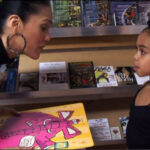Pierre-Auguste Renoir, a master of Impressionism, captured fleeting moments of life with vibrant brushstrokes and an astute eye for human emotion. Among his most celebrated works are his dance paintings, particularly the captivating “Dance in the Country” series. These paintings, more than just depictions of social gatherings, offer a profound insight into the passions, flirtations, and subtle social dynamics of 19th-century French society. Often analyzed for their Impressionistic technique, the true depth of these pieces lies in the stories whispered by the figures on the canvas, especially when we consider the nuances of Dance In The Country Painting.
The Allure of Dance in the Country: A Closer Look at Renoir’s Masterpieces
Renoir painted two significant versions of dance in the country painting alongside his “Dance in the City” in 1883. These were initially showcased separately after being sold by Paul Durand-Ruel, the art dealer instrumental in popularizing the Impressionists. Seeing them together, however, as in the Inventing Impressionism exhibitions, provides a unique opportunity to contrast the energy and narratives Renoir crafted within each scene.
Contrasting Country and City Dances: Initial Impressions
At first glance, Renoir’s dance in the country painting seems to burst with a raw, unbridled energy, markedly different from the more restrained “Dance in the City.” In the country scenes, men appear less formal, women’s attire is relaxed, and the overall atmosphere suggests spontaneity and genuine emotion. The ballroom scene, with its formal setting of columns and potted plants, initially appears subdued in comparison.
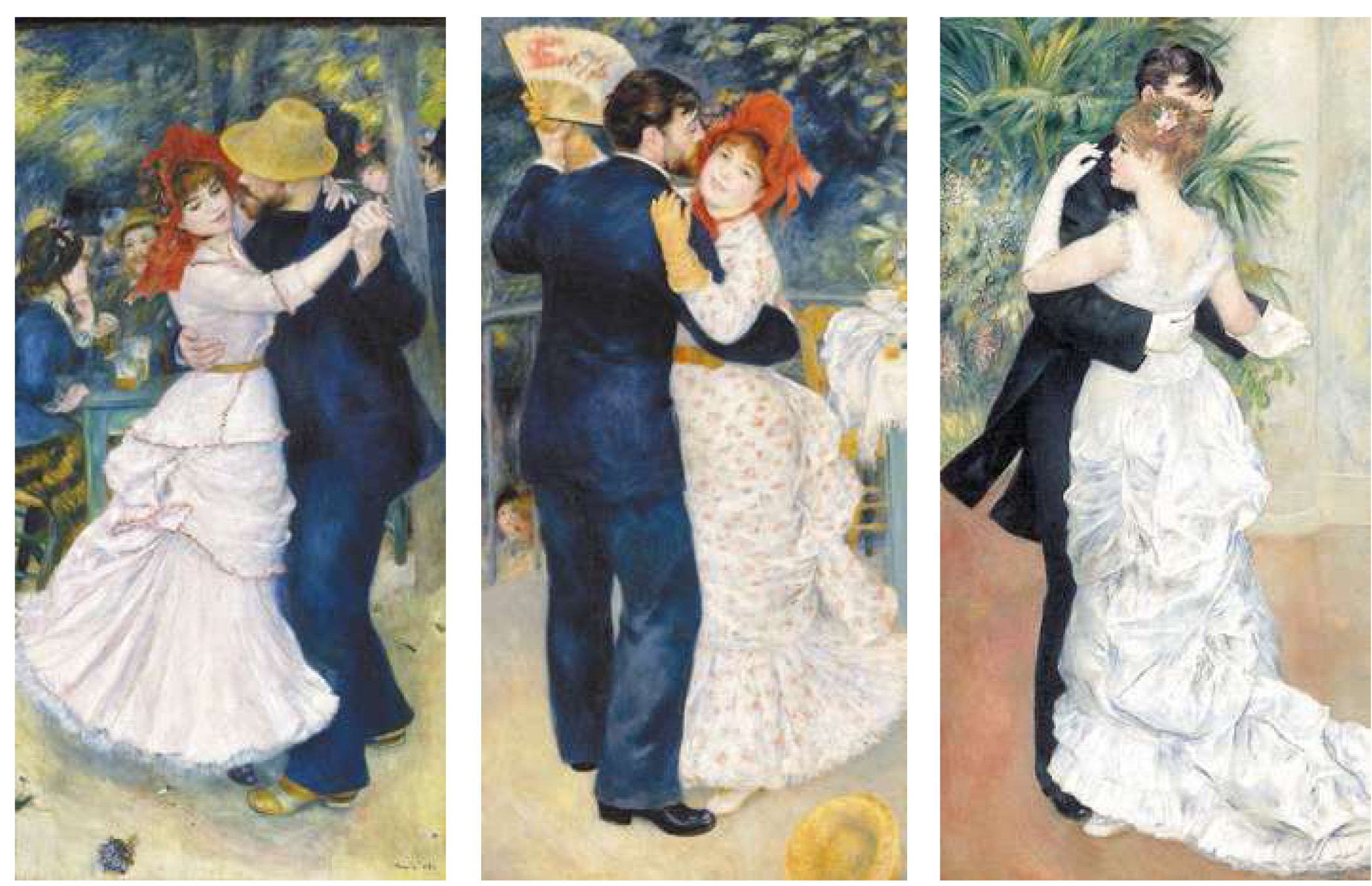 Dance at Bougival, 1883 by Pierre-Auguste Renoir. A vibrant depiction of an outdoor dance with a couple in the foreground, showcasing dynamic movement and lively atmosphere characteristic of country festivities.
Dance at Bougival, 1883 by Pierre-Auguste Renoir. A vibrant depiction of an outdoor dance with a couple in the foreground, showcasing dynamic movement and lively atmosphere characteristic of country festivities.
Dance at Bougival, 1883 by Pierre-Auguste Renoir. A vibrant depiction of an outdoor dance with a couple in the foreground, showcasing dynamic movement and lively atmosphere characteristic of country festivities.
However, this initial impression only scratches the surface. Looking closer, we realize that within the two dance in the country painting variations themselves, and even within the seemingly formal ballroom scene, Renoir masterfully weaves intricate tales of human interaction.
Deeper Dive into “Dance in the Country”: Unveiling Hidden Narratives
Let’s focus on the central couple in “Dance in the Country.” They appear to have eagerly joined the dance floor. The man’s firm grip on his partner’s hand suggests eagerness, yet she subtly maintains her independence, still holding onto her fan. Her gloves remain on, creating a slight barrier. The man’s passion is evident – his dropped hat unnoticed, his face close to hers, eyes fixed upon her.
However, the woman’s portrayal is complex. While maintaining a formal distance in her upper body, her dress, painted intimately against his leg, speaks volumes. Renoir uses delicate details to convey unspoken emotions.
 Close-up detail of the central couple in Renoir's Dance in the Country painting. Focus on the woman's dress subtly touching the man's leg, highlighting the intimate proximity and unspoken connection between them.
Close-up detail of the central couple in Renoir's Dance in the Country painting. Focus on the woman's dress subtly touching the man's leg, highlighting the intimate proximity and unspoken connection between them.
Close-up detail of the central couple in Renoir’s Dance in the Country painting. Focus on the woman’s dress subtly touching the man’s leg, highlighting the intimate proximity and unspoken connection between them.
The soft blue reflection on her dress indicates minimal space between them, the shaded border further emphasizing the closeness. Yet, her hand rests lightly on his shoulder, and her gaze drifts towards the viewer, the artist. She is aware of being observed, engaging in a delicate dance of flirtation with both her partner and the onlooker.
 Close-up of the woman's face in Renoir's Dance in the Country painting. Her eyes subtly glance towards the observer, hinting at her awareness and a playful interaction with both her dance partner and the viewer.
Close-up of the woman's face in Renoir's Dance in the Country painting. Her eyes subtly glance towards the observer, hinting at her awareness and a playful interaction with both her dance partner and the viewer.
Close-up of the woman’s face in Renoir’s Dance in the Country painting. Her eyes subtly glance towards the observer, hinting at her awareness and a playful interaction with both her dance partner and the viewer.
Turning to the couple on the left in “Dance at Bougival,” the dynamic shifts dramatically. This dance in the country painting portrays a more intense, almost predatory interaction. Renoir often used backgrounds to reflect personality, and here, the lively yet slightly overwhelming crowd of men around the women creates a sense of pursuit.
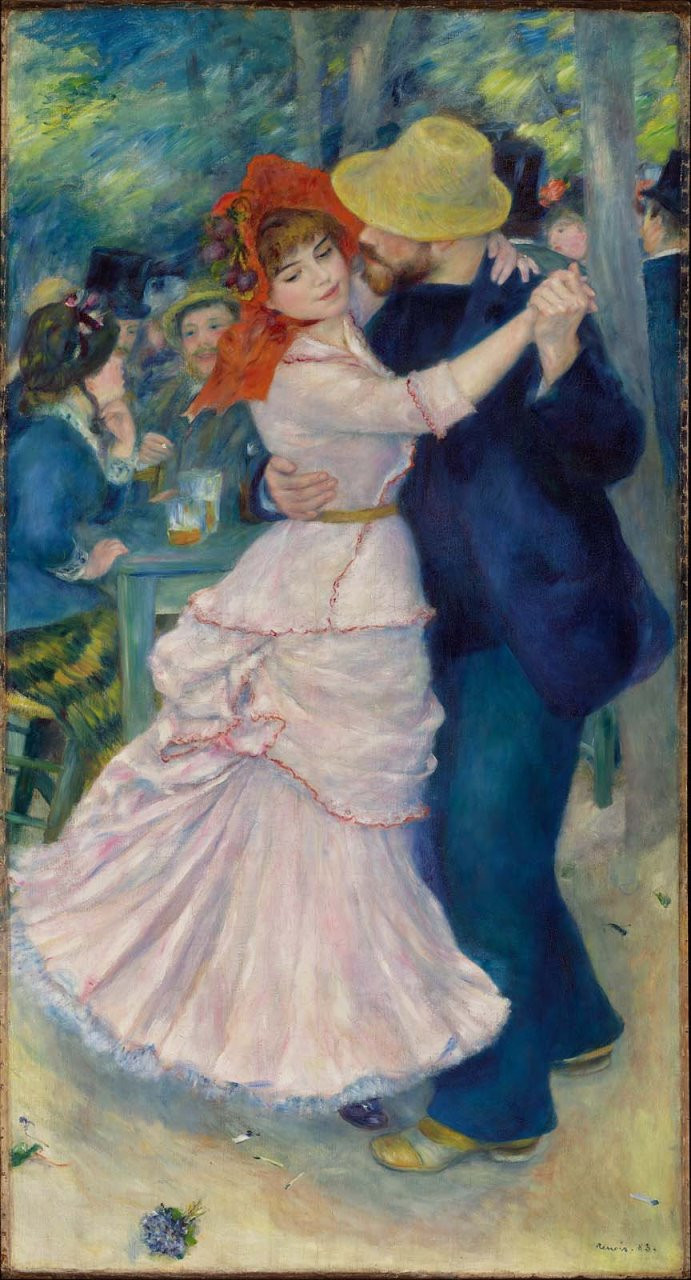 The left couple in Renoir's Dance at Bougival, emphasizing the man's casual attire and assertive posture compared to the woman's slightly averted gaze and hand position. Illustrates a more dramatic and less balanced dynamic between the pair.
The left couple in Renoir's Dance at Bougival, emphasizing the man's casual attire and assertive posture compared to the woman's slightly averted gaze and hand position. Illustrates a more dramatic and less balanced dynamic between the pair.
The left couple in Renoir’s Dance at Bougival, emphasizing the man’s casual attire and assertive posture compared to the woman’s slightly averted gaze and hand position. Illustrates a more dramatic and less balanced dynamic between the pair.
The man’s informal attire contrasts sharply with the more traditionally dressed gentleman in the central couple, suggesting a disregard for social norms, perhaps even a wilder nature. His grip and posture are assertive, while the woman, though her hand is draped over his neck, averts her face, possibly resisting a forced kiss.
 Full view of the left couple in Dance at Bougival painting by Renoir. Depicts the passionate yet tense interaction between the dancers, highlighting the contrasting body language and emotional undertones in the country dance scene.
Full view of the left couple in Dance at Bougival painting by Renoir. Depicts the passionate yet tense interaction between the dancers, highlighting the contrasting body language and emotional undertones in the country dance scene.
Full view of the left couple in Dance at Bougival painting by Renoir. Depicts the passionate yet tense interaction between the dancers, highlighting the contrasting body language and emotional undertones in the country dance scene.
Unlike the subtle connection in the central couple, here, there’s a visible separation at the lower bodies, emphasized by blue tones that suggest motion and distance.
 Detail of the lower bodies of the left couple in Dance at Bougival. Focus on the blue blur and clear lines indicating movement and separation, contrasting with the intimate connection of the central couple's depiction.
Detail of the lower bodies of the left couple in Dance at Bougival. Focus on the blue blur and clear lines indicating movement and separation, contrasting with the intimate connection of the central couple's depiction.
Detail of the lower bodies of the left couple in Dance at Bougival. Focus on the blue blur and clear lines indicating movement and separation, contrasting with the intimate connection of the central couple’s depiction.
Her gaze is directed downwards, towards a fallen flower on the floor – a discarded bloom mirroring the man’s suit color. This symbol suggests a caution, a silent warning against fleeting romance, hinting at the woman’s apprehension despite the man’s advances.
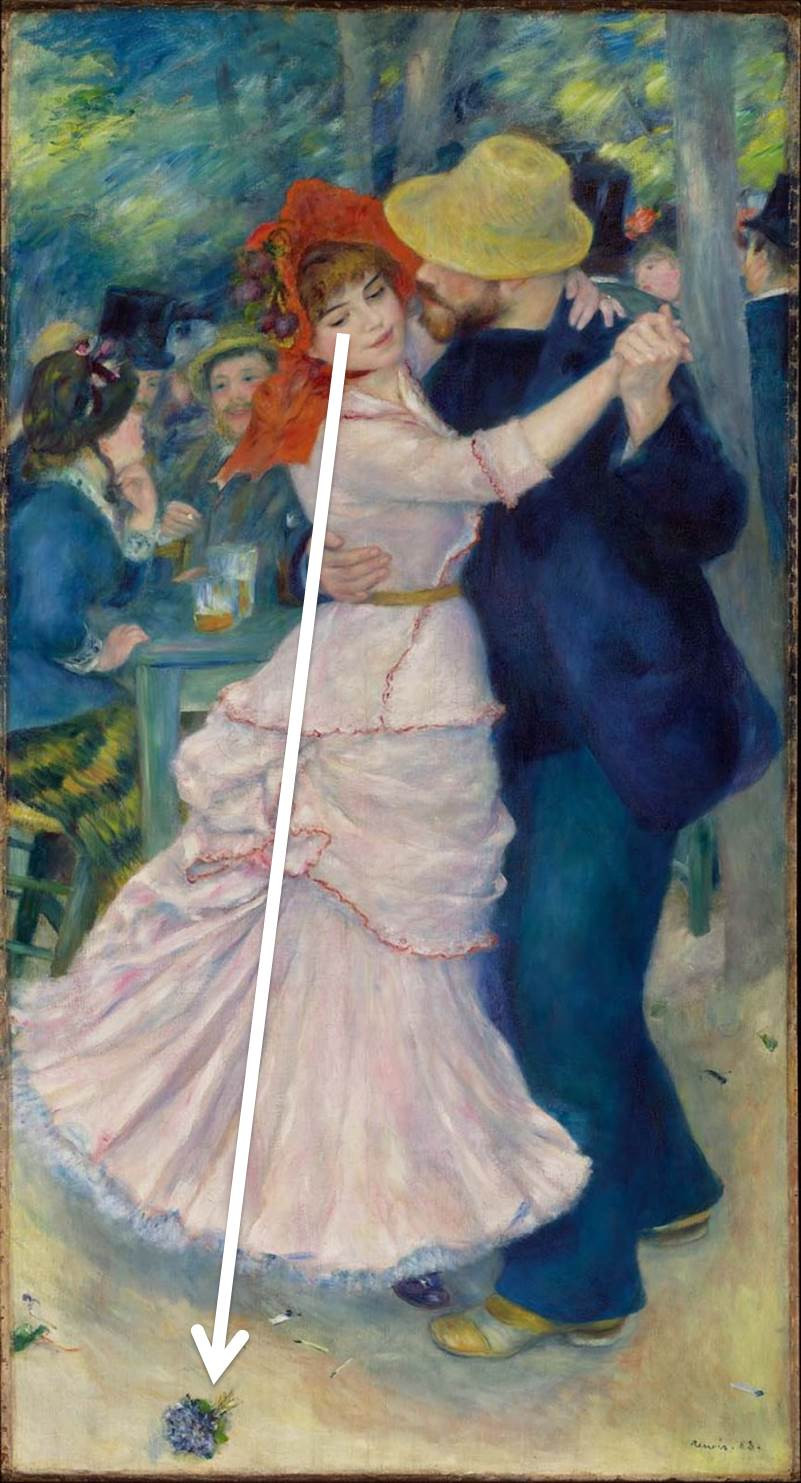 Line of sight analysis in Dance at Bougival, tracing the woman's gaze downwards to a flower on the floor. Symbolically connects her hesitation and contemplation about the fleeting nature of romance and the man's intentions.
Line of sight analysis in Dance at Bougival, tracing the woman's gaze downwards to a flower on the floor. Symbolically connects her hesitation and contemplation about the fleeting nature of romance and the man's intentions.
Line of sight analysis in Dance at Bougival, tracing the woman’s gaze downwards to a flower on the floor. Symbolically connects her hesitation and contemplation about the fleeting nature of romance and the man’s intentions.
Passion Beyond the Ballroom: Finding Depth in “Dance in the City”
Even “Dance in the City,” initially appearing as a more controlled depiction, reveals its own subtle passions upon closer examination. While the man’s face is largely obscured, the woman’s expressions and gestures are telling.
 Partial view of the man in Renoir's Dance in the City painting. Although his face is not fully visible, his posture and presence contribute to the overall formal and intimate atmosphere of the ballroom dance scene.
Partial view of the man in Renoir's Dance in the City painting. Although his face is not fully visible, his posture and presence contribute to the overall formal and intimate atmosphere of the ballroom dance scene.
Partial view of the man in Renoir’s Dance in the City painting. Although his face is not fully visible, his posture and presence contribute to the overall formal and intimate atmosphere of the ballroom dance scene.
Her hand gesture, reminiscent of shadow puppetry, paired with her slightly parted lips, suggests a hidden dream of intimacy beneath the formal setting.
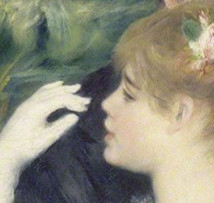 Close-up of the woman's hand and lips in Dance in the City. Her hand gesture and slightly parted lips hint at a suppressed desire and romantic dream within the formal ballroom setting, adding depth to her character.
Close-up of the woman's hand and lips in Dance in the City. Her hand gesture and slightly parted lips hint at a suppressed desire and romantic dream within the formal ballroom setting, adding depth to her character.
Close-up of the woman’s hand and lips in Dance in the City. Her hand gesture and slightly parted lips hint at a suppressed desire and romantic dream within the formal ballroom setting, adding depth to her character.
Her dress, seemingly endless and flowing upwards, could symbolize a burgeoning, innocent passion that is subtly unfolding even within the constraints of the ballroom.
Conclusion
Renoir’s dance paintings, particularly his explorations of dance in the country painting, are far more than just beautiful Impressionistic scenes. They are windows into the complex social and emotional landscapes of 19th-century France. By meticulously observing body language, subtle details, and symbolic elements, Renoir invites us to become participants in these narratives, to construct our own stories from the glimpses of passion and human interaction he so masterfully captured. Experiencing these paintings together allows for a richer understanding of Renoir’s genius and the enduring power of dance in the country painting to reveal the depths of human emotion.
Renoir’s Dance paintings trio, showcasing Dance at Bougival, Dance in the Country, and Dance in the City together. Emphasizes the collective impact and contrasting narratives within Renoir’s dance series, inviting viewers to appreciate the full scope of his artistic vision.

